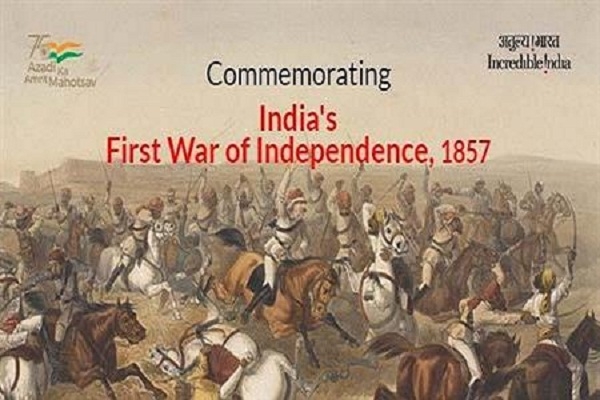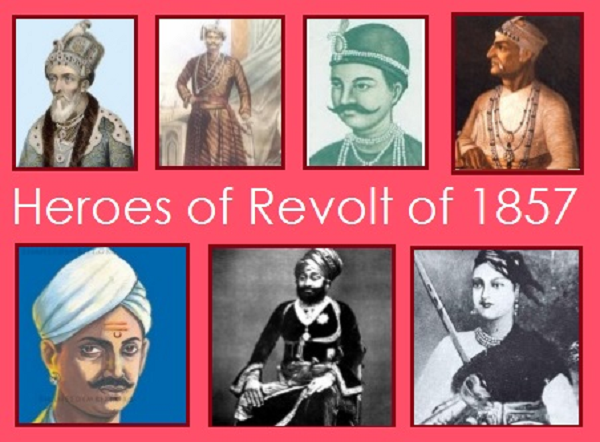Some musings on Bharat's First War of Independence

May 10 every year is observed as an anniversary of the First War of Independence that Bharat fought against the British East India Company to liberate our motherland from foreign occupation. It was a wonderful, amazing, and unique event in world history which shook the whole world in general and British Indian Empire in particular. It was a collective and countrywide challenge of the People of Bharat against the imperialist British Government. Millions of people were killed in it. The British not only committed genocide but also carried out terrible plunder. This struggle lasted more than a year in a row.
The British misinformation machinery was out to establish that this was not a War of Independence but just a ‘Sepoy Mutiny’ led by some disgruntled soldiers of the British Army and some princely states of Bharat. They also spread the misinformation that this ‘war’ was confined to the North and that the Southern states and principalities did not participate in it. Both these were proved wrong by the book that came out coinciding with the golden jubilee of the War of Independence in 1907 by none other than the great son of Mother Bharat who not only sacrificed his all at the altar of the motherland but lived to face the vagaries of the unfriendly Congress government and leaders post-independence yet loved this country and its people beyond limits. Yes, I am referring to Veer Vinayak Damodar Sawarkar, who dared the British in their own lands by publishing this great book in 1907 and told the world that 1857 was not a ‘Sepoy Mutiny’ but Bharat’s First War of Independence.
Blasting the myth that it was confined to the North of Bharat, Sawarkar firmly established that the whole of India had fought this battle of independence collectively. The whole country fought this war-Soldiers, feudal, peasants, laborers, Dalits, women, and intellectuals all fought for justice. This was corroborated by Justine MacCarthy in “History of our own Times where the author says: “The reality is that there was a revolt against the British rule by the people of the entire region of the north and North West of India.”
The Freedom Struggle of 1857 was not merely the whims of the kings and some soldiers in power. That attempt may have failed, but it was fruitful for the future. In spite of all the brutality, the British could not suppress the desire of the Bharatiya people to achieve independence.
Sardar Panikkar writes in 'A Survey of Indian History': "Everyone had the same and the similar objective - to get national independence by driving the British out of the country. From this point of view, you cannot call it a rebellion. This was a great national uplift. ”

The British had badly crushed the intense desire of the Bharatiya people to achieve independence, it is said - the reality is that this was the beginning of the collective efforts to achieve independence. It was the beginning of the throwing of the yoke off the British shoulders that not only continued but also affected the Bharat of the future at large.
There are three important dimensions of the 1857 revolution. In the years that followed these three dimensions became more vocal. Firstly, there were innumerable attempts both peaceful and revolutionary, to liberate the motherland. Secondly, some people like Lala Hardayal, Shyamji Krishna Verma, Veer Savarkar, Madanlal Dhingra, Sardar Udham Singh, Madam Cama, Ras Bihari Bose, and Netaji Subhash Chandra Bose migrated to other countries in Europe and the Americas and created an atmosphere in favor of freedom and assisted the efforts being made in Hindustan for independence. And, thirdly, satyagraha and non-violent movements across the country endeavored in Akhil Bharatiya manner elucidating the participation of the masses under the leadership of M. K. Gandhi and other leaders.
Sardar Panikkar writes in 'A Survey of Indian History' - "Everyone had the same and the similar objective - to get national independence by driving the British out of the country. From this point of view, you cannot call it a rebellion. This was a great national uplift. ”
The first flame of rebellion against the British was kept alive by Vasudev Balwant Phadke who inspired the people to sacrifice their all at the altar of Mother Bharat and try to free them from slavery and misery. The Amrit Bazar Patrika wrote about this first revolutionary in its November 1879 issue:
“He had all the great personalities who are sent to the world for the attainment of the work of significance. He was an angel. The height of his personality will be a comparison with the Satpura and the Himalayas as compared to that of a normal human being.”
Conversion caused the rebellion:
The emphasis of the East India Company was on converting the Hindus of Bharat to Christianity in order to expand the ‘Empire of the God in Heaven’. Initially, the Company was not sponsoring conversions of the native people but there was a group of MPs and Christian church leaders in Britain that batted consistently for allowing the missionaries to work in Bharat and undertake proselytizing activities.
By the Charter Act of 1813, Christian missionaries were permitted to enter the Company's territories in Bharat to propagate their religion and spread Western education. The Christian missionaries took every opportunity to ridicule the Hindu as well as the Islamic religion. They denounced idolatry, ridiculed the Hindu gods and goddesses, and criticized the philosophy and principles of Hinduism and Islam. The teaching of Christian doctrines was made compulsory in educational institutes run by missionaries.
Thus, the interference of the British authorities in social customs and practices through social legislation and the encouragement given by the government to Christian missionaries in their proselytizing activities created a sense of apprehension and hatred in the minds of Indians. (Patrick Brantlinger, Rule of Darkness, pg 202)
In the British military cantonments, Ram, Krishna, the Prophet, the Vedas, and the Qur'an were abused by the Christian missionaries. The soldiers were punished when they resisted mass conversion. The discontent of the soldiers began to swell inside as the activities of the Christian Missionaries grew with the government assistance.
In 1857, the Chairman of the Board of Directors of the East India Company said in a speech in the House of Commons regarding the Christianization of Hindustan: "God has handed over the vast empire of Hindustan to England; it is so that the Christian flag should be hoisted from one end of Hindustan to the other. Each should put all his might and work hard to do the great work of Christianizing Hindustan so that there is no stone unturned”.
The vicious cycle of conversion was also carried out among the soldiers. An officer (British) of the Bengali Army wrote in his report: "For the last 28 years, I have been constantly working to Christianize the soldiers because it was my military duty to free the Indian soldiers from the claws of Satan and take refuge in Jesus.” (Response to the Freedom Struggle of 1857 by Sridhar Paradkar) (To be continued…)


